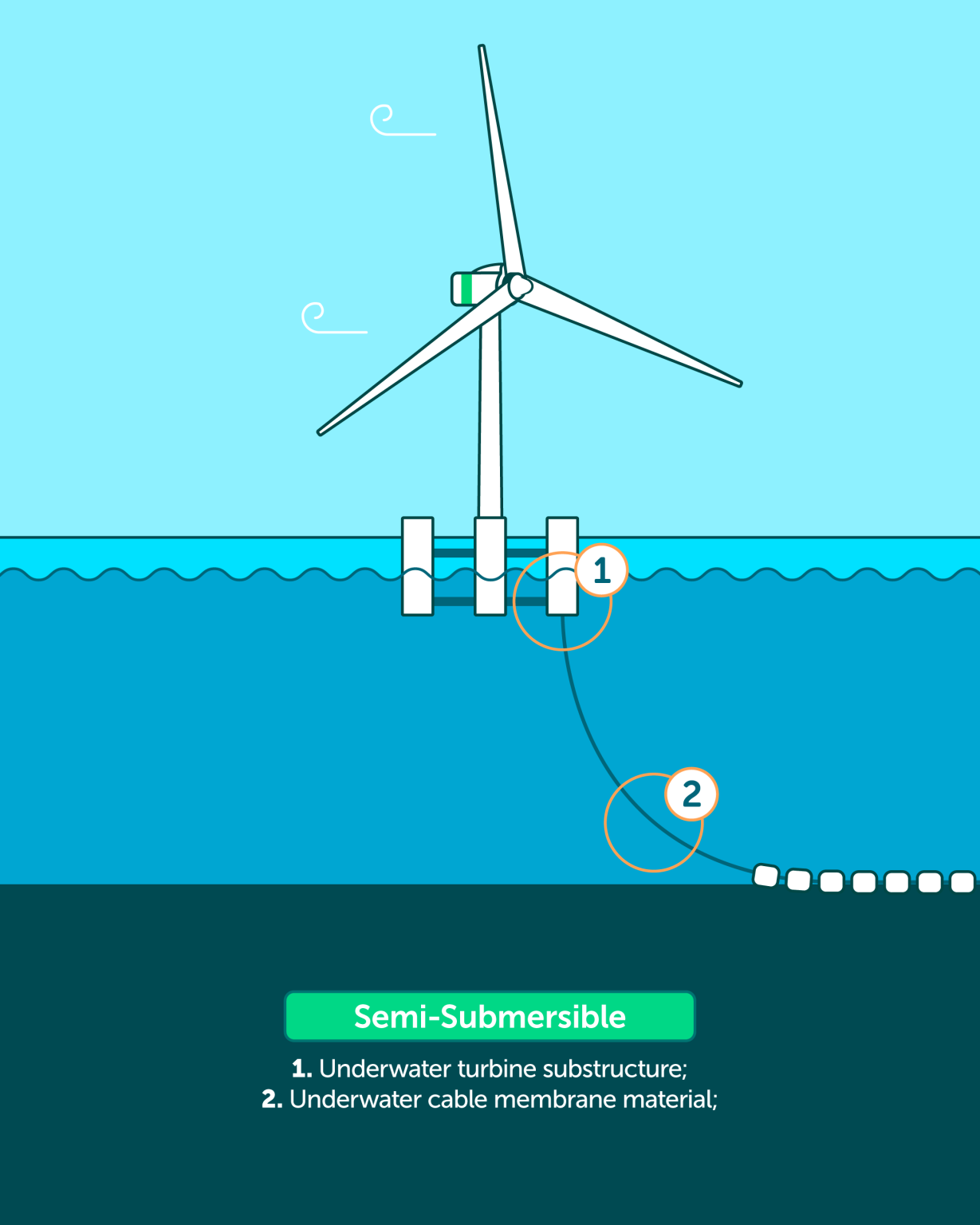In this Open Challenge, we seek innovative nature-inclusive concepts for floating offshore wind infrastructure. We look for concepts targeting:
We invite innovators to think outside the box and propose conceptual designs that address these challenges, even if they are still in the early stage of development.
While the focus of the Challenge is on floating wind infrastructure, concepts for floating structures supporting other renewable energy sources (e.g. solar) will be considered.
This challenge is open to everyone (e.g., SMEs, start-ups) from any country and of any size. There are no specific eligibility requirements for companies.


The winning concept will be upscaled to TRL5 (Technology validated in relevant hydrodynamic environment) [9].
The solution will be presented at WindEurope [10] Annual Event 2026 in Madrid, attended by members across the entire wind energy value chain.
Multi-disciplinary expert sessions with relevant NiD4OCEAN partners from across the value chain to improve technical design and/or business case, including developers, contractors, and research institutes.
[9] Please refer to details here concerning Deltares hydrodynamic, geotechnical and biological, chemical and physical research facilities.
[10] WindEurope is the voice of the wind industry, actively promoting wind energy across Europe. They have over 600 members from across the whole value chain of wind energy: wind turbine manufacturers, component suppliers, power utilities and wind farm developers, financial institutions, research institutes and national wind energy associations
Note this is a pre-announcement. The formal call announcement, including detailed requirement guidelines, is expected in mid-May 2025. Below is a tentative timeline for the Open Challenge.
NiD4OCEAN will be represented at WindEurope 2025 in Copenhagen. Visit us at the RGI booth to learn more about this Open Challenge.
If you have questions or comments, feel free to contact us at nid4ocean@niva.no
NID4OCEAN Partners and collaborators involved in this Open Challenge: Norwegian Institute for Water Research (NIVA), Akvaplan-NIVA, Spanish National Research Council (CSIC), Wageningen Research (WR), Stichting Deltares (Deltares), Danish Technical University (DTU), Klaipeda University (KU), North Sea Foundation (NSF), Science Crunchers (ScC), Renewables Grid Initiative (RGI), DNV, Equinor, and ScottishPower Renewables.
Below are some general specifications about floating wind infrastructures:
The expected expansion of offshore renewables to meet global, European, and national decarbonisation targets must be developed in a way that does not significantly harm the marine environment and the wellbeing of local (coastal) communities and, where possible, contributes to restoration goals [1-3].
In recent years, there has been a considerable increase in nature-inclusive concepts aimed at mitigating negative effects (i.e. mitigation measures) or restoring and/or enhancing certain habitats (i.e. nature-inclusive designs) [4-5]. Existing concepts have mostly been tested in bottom-fixed offshore wind farms, including optimised scour protection, optimised cable protection layers, add-on structures and stand-alone units [6-8].
However, there is a lack of expertise and solutions for floating offshore wind turbines and their associated infrastructure. Floating offshore wind farms are fundamentally different from bottom-fixed turbines, as they are placed in deeper waters (>50 m depth), further from shore, using floating structures anchored to the seabed by mooring lines or chains (see section “Additional information about floating wind structures” below).
As such, they are expected to have different impacts on local marine ecosystems compared to bottom-fixed (e.g. wildlife entanglement, continuous chain dragging of the seabed, anchor’s impacts, etc.), but may also offer new opportunities for biodiversity restoration when placed in degraded habitats. It is therefore critical to develop novel nature-inclusive concepts for this technology and explore the transferability of existing solutions currently applicable only to bottom-fixed offshore wind. An important aspect is ensuring these concepts are scalable and feasible for large-scale deployment in floating offshore wind farms.
This Open Challenge is organized in the frame of the Horizon Europe project NiD4OCEAN (Nature-inclusive Designs for reconciling offshore renewables with ocean protection). The project’s overall goal is to advance the emerging field of nature-inclusive designs (and nature-based solutions in general) for offshore renewables, and provide effective, context-dependent solutions to industry, managers, and policy makers, to support of the global and EU targets for carbon neutrality, biodiversity restoration, and a sustainable, inclusive ocean economy.
The project is organising an Innovation Challenge Series, which includes this Open Challenge aimed at innovators, Small and Medium Enterprises (SME).
[1] Galparsoro et al. (2022) Reviewing the ecological impacts of offshore wind farms. npj Ocean Sustain 1:1
[2] Lemasson et al. (2024). A global meta-analysis of ecological effects from offshore marine artificial structures. Nature Sustainability, 7(4), 485-495
[3] Watson et al. (2024). The global impact of offshore wind farms on ecosystem services. Ocean & Coastal Management, 249, 107023
[4] link to NiD4OCEAN website: what are NiDs
[5] Ocean – Offshore Coalition for Energy and Nature (2024) Avoidance and minimisation from offshore wind and grid infrastructure
[6] Hermans et al. (2020) Nature-Inclusive Design: A Catalogue for Offshore Wind Infrastructure. The Hague: Witteveen+Bos 50pp.
[7] Pardo et al. (2023) A synthesis review of nature positive approaches and coexistence in the offshore wind industry. ICES Journal of Marine Science, fsad191
[8] The Toolbox. Rich North Sea. Website.
The views and opinions expressed on this website are those of the project team and do not necessarily reflect the views of the individual partner organisations. The European Commission is not responsible for any use that may be made of the information contained herein.
NiD4OCEAN, Nature-inclusive Designs for Reconciling Offshore Renewables with Ocean Protection project is funded by the European Union under the Horizon Europe programme (grant agreement no. 101156861).
